Ammar Belatreche
Robust Palm-Vein Recognition Using the MMD Filter: Improving SIFT-Based Feature Matching
Mar 03, 2025Abstract:A major challenge with palm vein images is that slight movements of the fingers and thumb, or variations in hand posture, can stretch the skin in different areas and alter the vein patterns. This can result in an infinite number of variations in palm vein images for a given individual. This paper introduces a novel filtering technique for SIFT-based feature matching, known as the Mean and Median Distance (MMD) Filter. This method evaluates the differences in keypoint coordinates and computes the mean and median in each direction to eliminate incorrect matches. Experiments conducted on the 850nm subset of the CASIA dataset indicate that the proposed MMD filter effectively preserves correct points while reducing false positives detected by other filtering methods. A comparison with existing SIFT-based palm vein recognition systems demonstrates that the proposed MMD filter delivers outstanding performance, achieving lower Equal Error Rate (EER) values. This article presents an extended author's version based on our previous work, A Keypoint Filtering Method for SIFT based Palm-Vein Recognition.
ILACS-LGOT: A Multi-Layer Contrast Enhancement Approach for Palm-Vein Images
Feb 26, 2025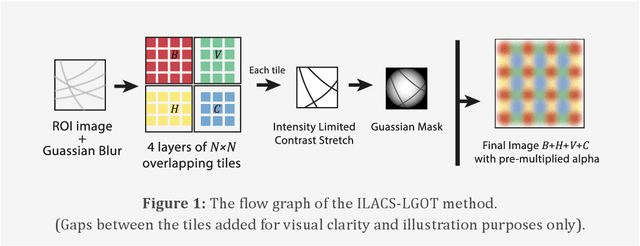



Abstract:This article presents an extended author's version based on our previous work, where we introduced the Multiple Overlapping Tiles (MOT) method for palm vein image enhancement. To better reflect the specific operations involved, we rename MOT to ILACS-LGOT (Intensity-Limited Adaptive Contrast Stretching with Layered Gaussian-weighted Overlapping Tiles). This revised terminology more accurately represents the method's approach to contrast enhancement and blocky effect mitigation. Additionally, this article provides a more detailed analysis, including expanded evaluations, graphical representations, and sample-based comparisons, demonstrating the effectiveness of ILACS-LGOT over existing methods.
Towards Accurate Binary Spiking Neural Networks: Learning with Adaptive Gradient Modulation Mechanism
Feb 20, 2025



Abstract:Binary Spiking Neural Networks (BSNNs) inherit the eventdriven paradigm of SNNs, while also adopting the reduced storage burden of binarization techniques. These distinct advantages grant BSNNs lightweight and energy-efficient characteristics, rendering them ideal for deployment on resource-constrained edge devices. However, due to the binary synaptic weights and non-differentiable spike function, effectively training BSNNs remains an open question. In this paper, we conduct an in-depth analysis of the challenge for BSNN learning, namely the frequent weight sign flipping problem. To mitigate this issue, we propose an Adaptive Gradient Modulation Mechanism (AGMM), which is designed to reduce the frequency of weight sign flipping by adaptively adjusting the gradients during the learning process. The proposed AGMM can enable BSNNs to achieve faster convergence speed and higher accuracy, effectively narrowing the gap between BSNNs and their full-precision equivalents. We validate AGMM on both static and neuromorphic datasets, and results indicate that it achieves state-of-the-art results among BSNNs. This work substantially reduces storage demands and enhances SNNs' inherent energy efficiency, making them highly feasible for resource-constrained environments.
Spiking Vision Transformer with Saccadic Attention
Feb 18, 2025Abstract:The combination of Spiking Neural Networks (SNNs) and Vision Transformers (ViTs) holds potential for achieving both energy efficiency and high performance, particularly suitable for edge vision applications. However, a significant performance gap still exists between SNN-based ViTs and their ANN counterparts. Here, we first analyze why SNN-based ViTs suffer from limited performance and identify a mismatch between the vanilla self-attention mechanism and spatio-temporal spike trains. This mismatch results in degraded spatial relevance and limited temporal interactions. To address these issues, we draw inspiration from biological saccadic attention mechanisms and introduce an innovative Saccadic Spike Self-Attention (SSSA) method. Specifically, in the spatial domain, SSSA employs a novel spike distribution-based method to effectively assess the relevance between Query and Key pairs in SNN-based ViTs. Temporally, SSSA employs a saccadic interaction module that dynamically focuses on selected visual areas at each timestep and significantly enhances whole scene understanding through temporal interactions. Building on the SSSA mechanism, we develop a SNN-based Vision Transformer (SNN-ViT). Extensive experiments across various visual tasks demonstrate that SNN-ViT achieves state-of-the-art performance with linear computational complexity. The effectiveness and efficiency of the SNN-ViT highlight its potential for power-critical edge vision applications.
QP-SNN: Quantized and Pruned Spiking Neural Networks
Feb 09, 2025



Abstract:Brain-inspired Spiking Neural Networks (SNNs) leverage sparse spikes to encode information and operate in an asynchronous event-driven manner, offering a highly energy-efficient paradigm for machine intelligence. However, the current SNN community focuses primarily on performance improvement by developing large-scale models, which limits the applicability of SNNs in resource-limited edge devices. In this paper, we propose a hardware-friendly and lightweight SNN, aimed at effectively deploying high-performance SNN in resource-limited scenarios. Specifically, we first develop a baseline model that integrates uniform quantization and structured pruning, called QP-SNN baseline. While this baseline significantly reduces storage demands and computational costs, it suffers from performance decline. To address this, we conduct an in-depth analysis of the challenges in quantization and pruning that lead to performance degradation and propose solutions to enhance the baseline's performance. For weight quantization, we propose a weight rescaling strategy that utilizes bit width more effectively to enhance the model's representation capability. For structured pruning, we propose a novel pruning criterion using the singular value of spatiotemporal spike activities to enable more accurate removal of redundant kernels. Extensive experiments demonstrate that integrating two proposed methods into the baseline allows QP-SNN to achieve state-of-the-art performance and efficiency, underscoring its potential for enhancing SNN deployment in edge intelligence computing.
Binary Event-Driven Spiking Transformer
Jan 10, 2025



Abstract:Transformer-based Spiking Neural Networks (SNNs) introduce a novel event-driven self-attention paradigm that combines the high performance of Transformers with the energy efficiency of SNNs. However, the larger model size and increased computational demands of the Transformer structure limit their practicality in resource-constrained scenarios. In this paper, we integrate binarization techniques into Transformer-based SNNs and propose the Binary Event-Driven Spiking Transformer, i.e. BESTformer. The proposed BESTformer can significantly reduce storage and computational demands by representing weights and attention maps with a mere 1-bit. However, BESTformer suffers from a severe performance drop from its full-precision counterpart due to the limited representation capability of binarization. To address this issue, we propose a Coupled Information Enhancement (CIE) method, which consists of a reversible framework and information enhancement distillation. By maximizing the mutual information between the binary model and its full-precision counterpart, the CIE method effectively mitigates the performance degradation of the BESTformer. Extensive experiments on static and neuromorphic datasets demonstrate that our method achieves superior performance to other binary SNNs, showcasing its potential as a compact yet high-performance model for resource-limited edge devices.
Ternary Spike-based Neuromorphic Signal Processing System
Jul 07, 2024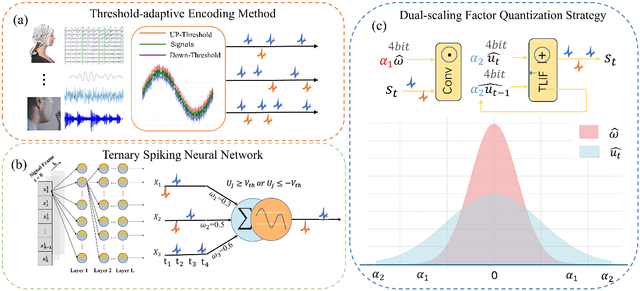
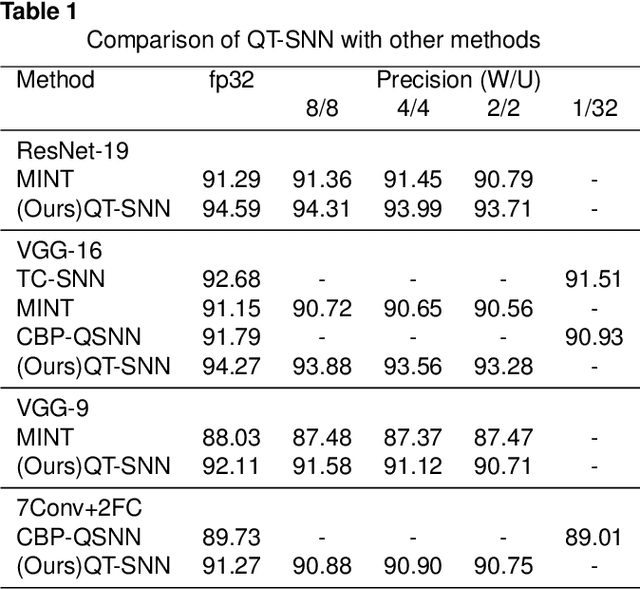


Abstract:Deep Neural Networks (DNNs) have been successfully implemented across various signal processing fields, resulting in significant enhancements in performance. However, DNNs generally require substantial computational resources, leading to significant economic costs and posing challenges for their deployment on resource-constrained edge devices. In this study, we take advantage of spiking neural networks (SNNs) and quantization technologies to develop an energy-efficient and lightweight neuromorphic signal processing system. Our system is characterized by two principal innovations: a threshold-adaptive encoding (TAE) method and a quantized ternary SNN (QT-SNN). The TAE method can efficiently encode time-varying analog signals into sparse ternary spike trains, thereby reducing energy and memory demands for signal processing. QT-SNN, compatible with ternary spike trains from the TAE method, quantifies both membrane potentials and synaptic weights to reduce memory requirements while maintaining performance. Extensive experiments are conducted on two typical signal-processing tasks: speech and electroencephalogram recognition. The results demonstrate that our neuromorphic signal processing system achieves state-of-the-art (SOTA) performance with a 94% reduced memory requirement. Furthermore, through theoretical energy consumption analysis, our system shows 7.5x energy saving compared to other SNN works. The efficiency and efficacy of the proposed system highlight its potential as a promising avenue for energy-efficient signal processing.
Q-SNNs: Quantized Spiking Neural Networks
Jun 19, 2024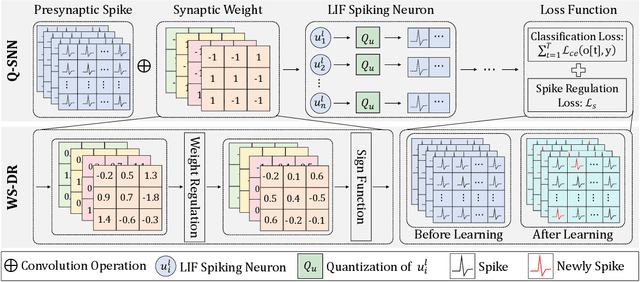
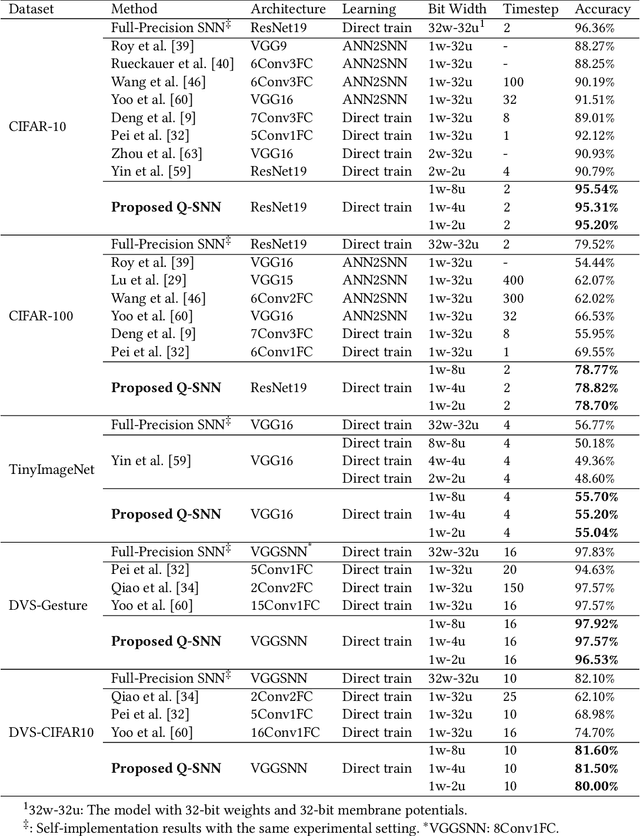
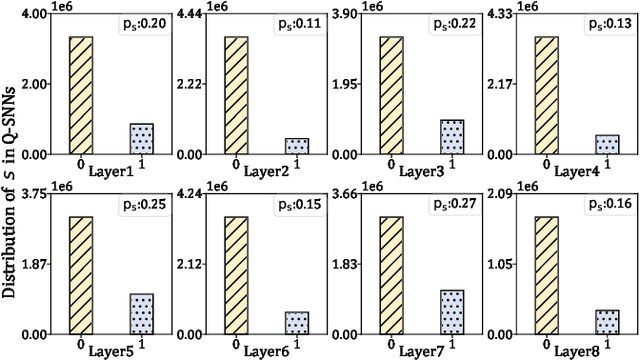
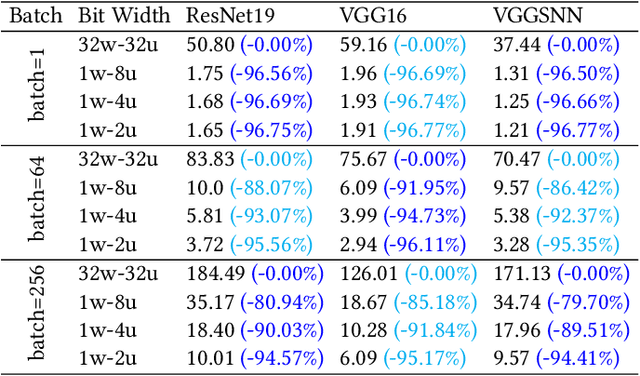
Abstract:Brain-inspired Spiking Neural Networks (SNNs) leverage sparse spikes to represent information and process them in an asynchronous event-driven manner, offering an energy-efficient paradigm for the next generation of machine intelligence. However, the current focus within the SNN community prioritizes accuracy optimization through the development of large-scale models, limiting their viability in resource-constrained and low-power edge devices. To address this challenge, we introduce a lightweight and hardware-friendly Quantized SNN (Q-SNN) that applies quantization to both synaptic weights and membrane potentials. By significantly compressing these two key elements, the proposed Q-SNNs substantially reduce both memory usage and computational complexity. Moreover, to prevent the performance degradation caused by this compression, we present a new Weight-Spike Dual Regulation (WS-DR) method inspired by information entropy theory. Experimental evaluations on various datasets, including static and neuromorphic, demonstrate that our Q-SNNs outperform existing methods in terms of both model size and accuracy. These state-of-the-art results in efficiency and efficacy suggest that the proposed method can significantly improve edge intelligent computing.
Event-Driven Learning for Spiking Neural Networks
Mar 01, 2024



Abstract:Brain-inspired spiking neural networks (SNNs) have gained prominence in the field of neuromorphic computing owing to their low energy consumption during feedforward inference on neuromorphic hardware. However, it remains an open challenge how to effectively benefit from the sparse event-driven property of SNNs to minimize backpropagation learning costs. In this paper, we conduct a comprehensive examination of the existing event-driven learning algorithms, reveal their limitations, and propose novel solutions to overcome them. Specifically, we introduce two novel event-driven learning methods: the spike-timing-dependent event-driven (STD-ED) and membrane-potential-dependent event-driven (MPD-ED) algorithms. These proposed algorithms leverage precise neuronal spike timing and membrane potential, respectively, for effective learning. The two methods are extensively evaluated on static and neuromorphic datasets to confirm their superior performance. They outperform existing event-driven counterparts by up to 2.51% for STD-ED and 6.79% for MPD-ED on the CIFAR-100 dataset. In addition, we theoretically and experimentally validate the energy efficiency of our methods on neuromorphic hardware. On-chip learning experiments achieved a remarkable 30-fold reduction in energy consumption over time-step-based surrogate gradient methods. The demonstrated efficiency and efficacy of the proposed event-driven learning methods emphasize their potential to significantly advance the fields of neuromorphic computing, offering promising avenues for energy-efficiency applications.
Spike-Timing-Dependent Back Propagation in Deep Spiking Neural Networks
Mar 26, 2020



Abstract:The success of Deep Neural Networks (DNNs) can be attributed to its deep structure, that learns invariant feature representation at multiple levels of abstraction. Brain-inspired Spiking Neural Networks (SNNs) use spatiotemporal spike patterns to encode and transmit information, which is biologically realistic, and suitable for ultra-low-power event-driven neuromorphic implementation. Therefore, Deep Spiking Neural Networks (DSNNs) represent a promising direction in artificial intelligence, with the potential to benefit from the best of both worlds. However, the training of DSNNs is challenging because standard error back-propagation (BP) algorithms are not directly applicable. In this paper, we first establish an understanding of why error back-propagation does not work well in DSNNs. To address this problem, we propose a simple yet efficient Rectified Linear Postsynaptic Potential function (ReL-PSP) for spiking neurons and propose a Spike-Timing-Dependent Back-Propagation (STDBP) learning algorithm for DSNNs. In the proposed learning algorithm, the timing of individual spikes is used to carry information (temporal coding), and learning (back-propagation) is performed based on spike timing in an event-driven manner. Experimental results demonstrate that the proposed learning algorithm achieves state-of-the-art performance in spike time based learning algorithms of SNNs. This work investigates the contribution of dynamics in spike timing to information encoding, synaptic plasticity and decision making, providing a new perspective to design of future DSNNs.
 Add to Chrome
Add to Chrome Add to Firefox
Add to Firefox Add to Edge
Add to Edge